North Vietnam, Ho Chi Minh, Second Series issued in 1951 with overprint of new values, 1954-December, 1956 (Michel Nr. 53 a&b and D8-9); It appears a large quantities of the 2nd Ho Chi Minh issue from 1948/1950 were still in postal archives but were un-useful due to their very low nominal values. Let’s recall that the Vietnamese currency was devalued 1:10 in June of 1951. This means the original 2D and 5D were only worth 0.2 and 0.5 New Dong. However the standard domestic letter rate already stood at 100 New Dong in 1955. In order to make these old stamps useful again and make use of precious raw material that was still scarce in North Vietnam, postal authorities decided to overprint the old stamps with new values. The 5 old Dong value in red and orange-red was uprated one hundred times to 50 New Dong. Why the authorities used 50 Dong is not known but clearly there must have been a purpose behind it. The 50 Dong represented a discounted intra-city rate (that was also common in Indochina) and it was probably also intended for lower cost “printed matter” mailings. Very few complete post pieces from the era survive as most local letters were destroyed due to war, high humidity or recycling so it is impossible to determine the actual purpose of the overprinted value. Of course, two stamps would have covered the standard letter rate so it is likely that the stamps served at least a dual purpose. The overprint was a fairly primitive affair and appears that the cliches were hand-made so each one is slightly different from one another. Michel identifies two different overprints that are basically characterized by the vertical line in the “5” of “50”. Type I shows a leveled horizontal line at the top of the “5” and Type II shows a horizontal line that is slightly angled upwards. Both overprints are intermingled on one and the same sheet. The Vietnamese Postage Stamp Catalogue reports that the overprints were produced in 1954, while both, Michel and Scott, report they were done in December of 1956. The Vietnamese catalogue appears to be more credible as the editor has used specimen that were cancelled on May, 21, 1955, which is well before the date proclaimed by Michel/Scott. Michel also writes that, while issued by the central postal authority in Hanoi, these stamps were mostly used in LK 3 (Lien Khu 3/Third Interzone) in the provinces of Ha Nam, Ha Dong and Ha Bing south of Hanoi.
Here is a mint pair of the the red stamp with Type I on both stamps.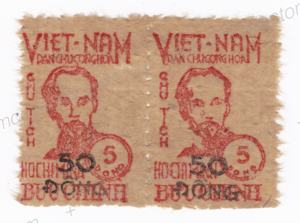
The difference between the two types becomes clearer under magnification.
This is a a mint Type I stamp in orange-red with a top margin.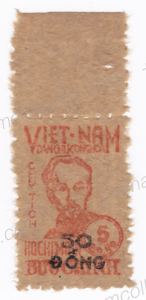
Looking at the magnification you can see the level line of the “5”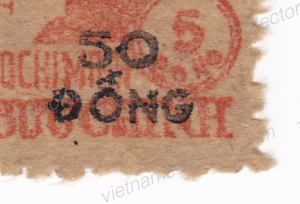
The is the Type II of the orange-red color stamp.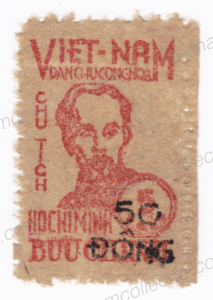
Looking at the magnification you can see the upward angle of the straight line in the “5”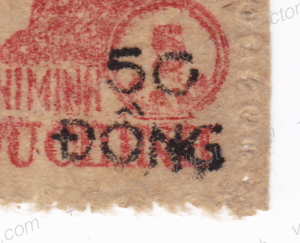
Determining the base color can be a bit tricky as there are also tonality issues on both colors. Sometimes the color is weaker and sometimes more intense. Make sure you make all comparisons under day-light as artifical light may alter the outcome. Here is a pair in red (Type I) side by side with a vertical strip of five stamps of the orange-red variety (Type II).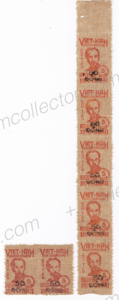
Michel values a mint stamp of both types at €100 for the red and €50 for the orange red base color. Scott values both colors at $90. All of these amounts are much too high. The mint stamps may have been rarer at one time but Cotevina (the Vietnamese philatelic company) sold entire sheets, of the orange-red variety, well into the 1990’s. The editor thinks that $25 for the red and $5 for the orange red stamp are much closer to market reality than current catalogue values. Michel has in the 2022 catalogue corrected the value of there mint stamps to Euro 20 for the red and Euro 10 for the orange red stamp.
This is not true for cancelled specimen. Given that most local mail did not survive climate, recycling and wars, very few cancelled stamps exist. They are most likely contained in older Eastern European collections as these countries had direct contact with North Vietnam at the time. In 25 years of collecting Vietnamese stamps the editor has only been able to collect a total of 9 used stamps. The editor would not sell one under $250 as they so hard to replace.
Here is a very rare block of four of the red base color with a Hanoi date cancel.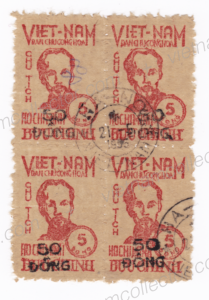
Here is a single specimen of the orange-red variety also cancelled in Hanoi.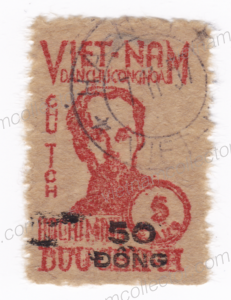
Beware of far out of date cancellations that were produced by the Vietnamese Post in the 1990’s and that show the five digit zip-code or stamps with indefinite cancels like the one below. Such stamps would not be worth more than mint ones. While this cancel may be genuine (the home made old hinge on the back suggests it is) this simply cannot be proven as there are too few details visible.
Overprint errors do exist. Here is a pair with the right stamp showing a double overprint:
and here 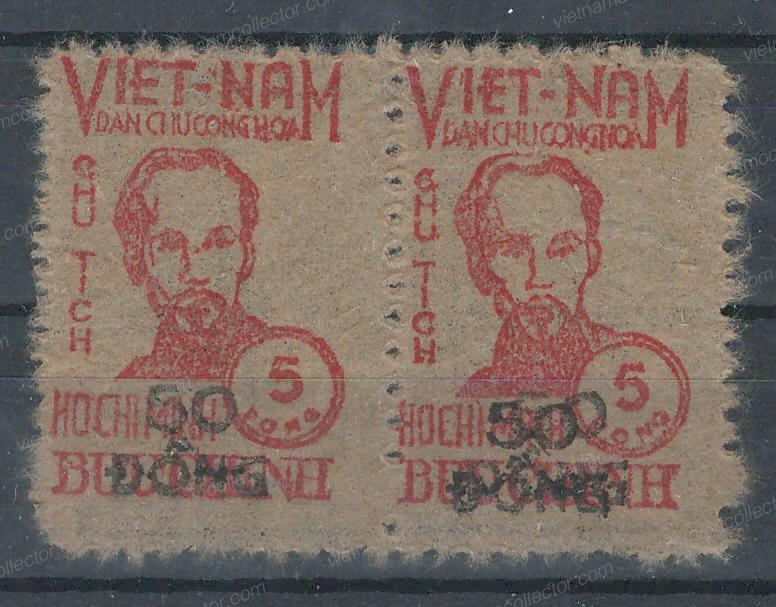 a pair with the left stamp showing a triple over-print
a pair with the left stamp showing a triple over-print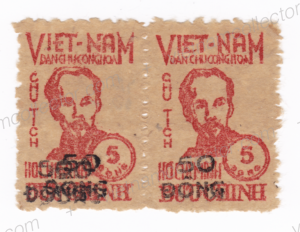 Complete letters exist but they are extremely rare and the editor has hence be unable to collect one so far.
Complete letters exist but they are extremely rare and the editor has hence be unable to collect one so far.
Postal authorities also prepared overprints that were to be used for official mail only. Instead of using New Dong though, they decided to denominate these stamps by the weight of husked rice (100g of rice). This made the stamps basically impervious to the rapid inflation occurring at the time. Michel reports that the overprints were prepared at the main post office in Hanoi but were mostly used in the 3rd Interzone (provinces of Ha Nam, Ha Dong and Hoa Ninh) south of Hanoi. There are two types of overprints that exist. One that shows a large “K” and smaller numbers and one that shows a smaller “k” and larger numbers. It appears that all stamps in one sheet are of the same type as this is the case with all the multiples of the editor. This view is confirmed by scans of complete sheets that are featured on SICP member Jean Goanvic’s website. Michel reports that the overprint only occurs on the brown and red base color but the editor does have some genuine specimens that show the overprint on the light-brown and orange-red base color. These are so far unlisted.
This is a small “K” with the large numbers in a rare block of six in the brown color. Notice the slightly different appearance of each cliche.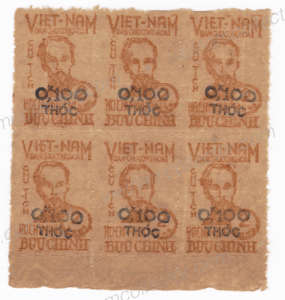
Here is the overprint magnified.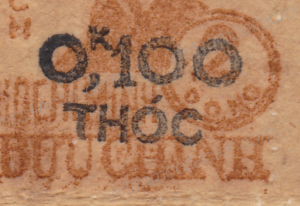
This is the large “K” with the large numbers in the light-brown color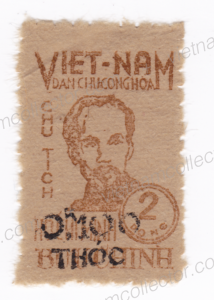
This is the large “K” with the small numbers in the light-brown color.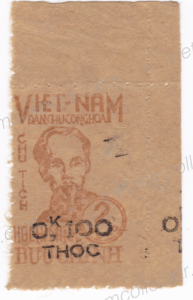
Again, a detailed scan of the overprint.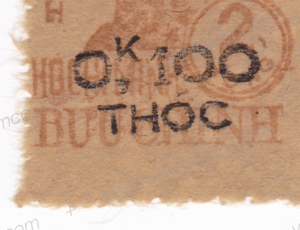
This is a rare block of four of the small “K” with the small number in the red base color. Notice the thin and partially missing margins; a sign that the paper was hand-made.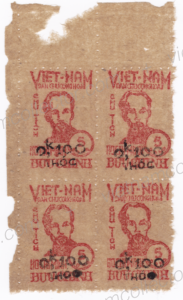
A detailed scan of the overprint.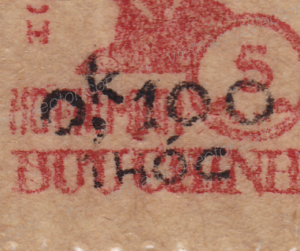
Mint sample of the “large K” on the red base color.
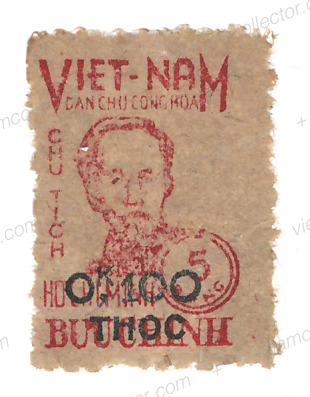
Detailed scan of the affected area.
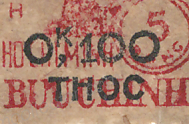
This is the small “K” with the small numbers on the orange-red base color.The overprint on the orange-red base color has not been catalogued yet . Since the orange-red base color represented the second print of this stamp, most of the red base color had already been used up by the time the overprint was applied. 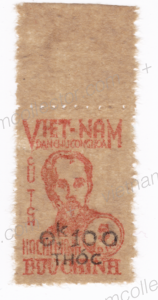
A detailed scan of the overprint.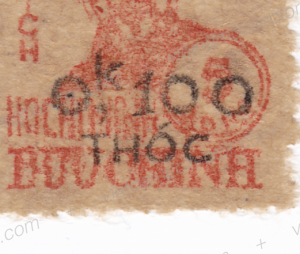
Cancelled versions of the overprinted stamps are exceedingly rare as they were basically used on intra-governmental correspondence which ended up in Government archives that were often destroyed during the war or raided by the enemy in order to obtain intelligence. However, cancelled to order sheets of the overprinted stamps were available from the official Vietnamese stamp agency Cotevina until the mid 1990’s. They carry the small modern Hanoi date canceller and are not worth nearly as much as stamps that were used in the 1950’s. Below is such a cancelled to order set.
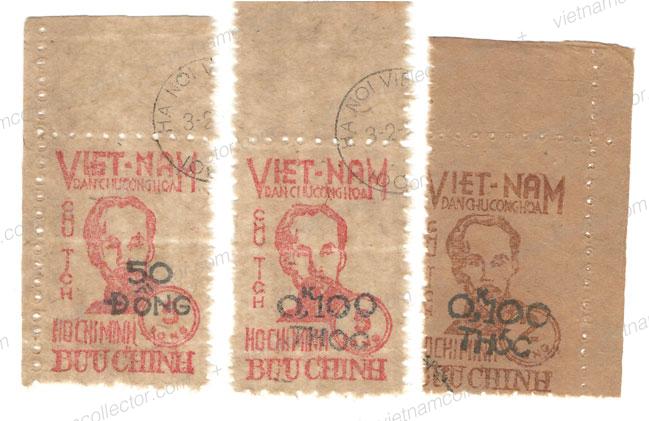
Both, Michel and Scott do value a mint pair of either type at €300 and $475, which may be a bit high. But keep in mind that most stamps offered today in the market place are forgeries. Once all the collectors that currently own forgeries realize this fact demand for the genuine item will go up and so will prices. They do not offer a value for used specimens and Michel just shows -.- which stands for price cannot be established due to a lack of market activity.
Forged overprints do exist. They are characterized by the fact that (i.e. the 1 and the two zeros are touching each other) on one forgery and all or the most right “0” in “100” are open to the right in another forgery (i.e. looking more like a “C” instead of a zero).
Below is the most primitive forgery. Here the “T” looks more like a “Y”. Both zeros of the nominal values are open to the right so basically represent large “C”s and the “H” in THOC is small and not large caps. Interestingly the forgery was cancelled by a modern Hanoi cancel on which the year was removed. So it is likely that these forgeries were made by a corrupt member of the postal organization.
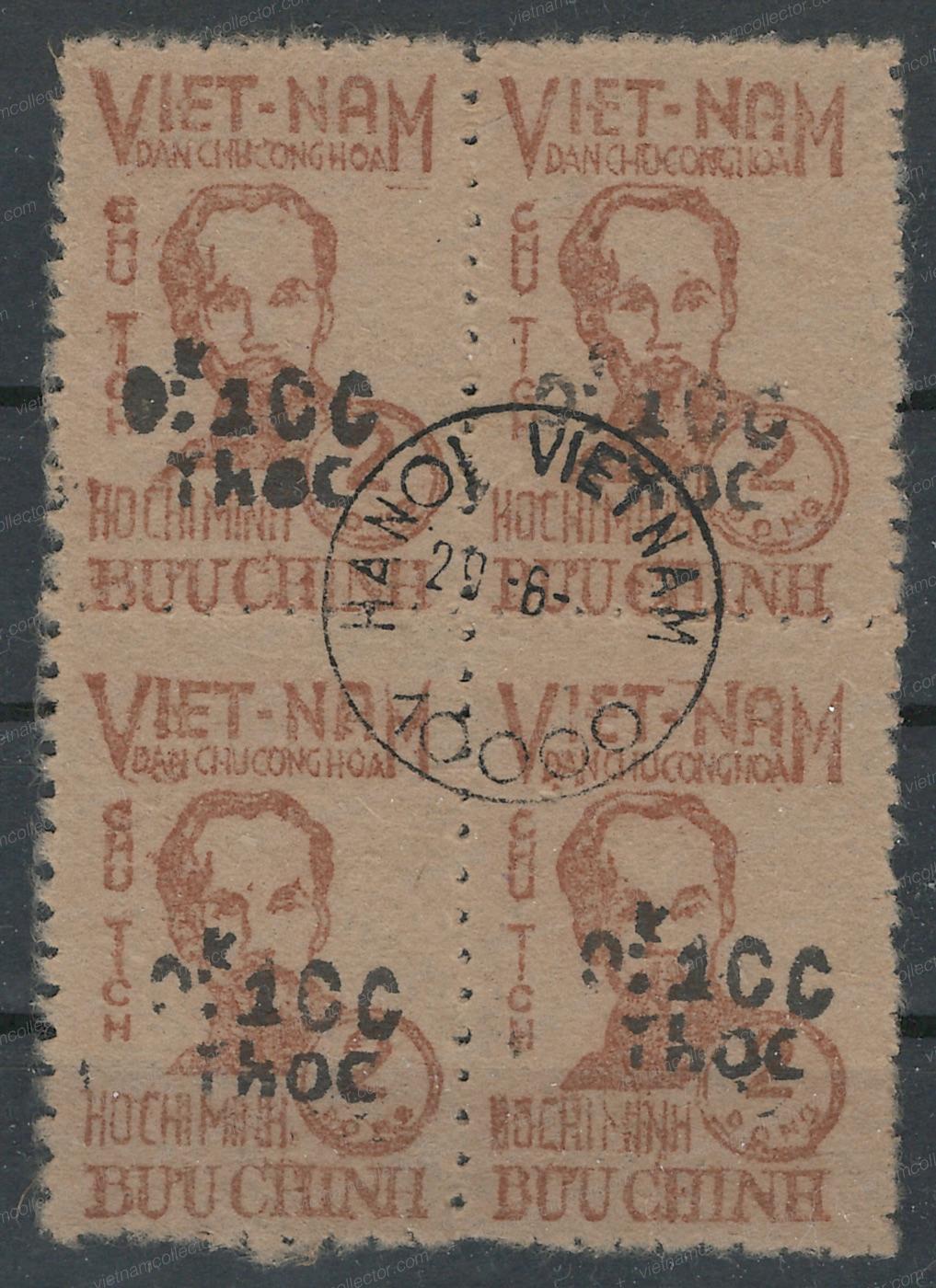
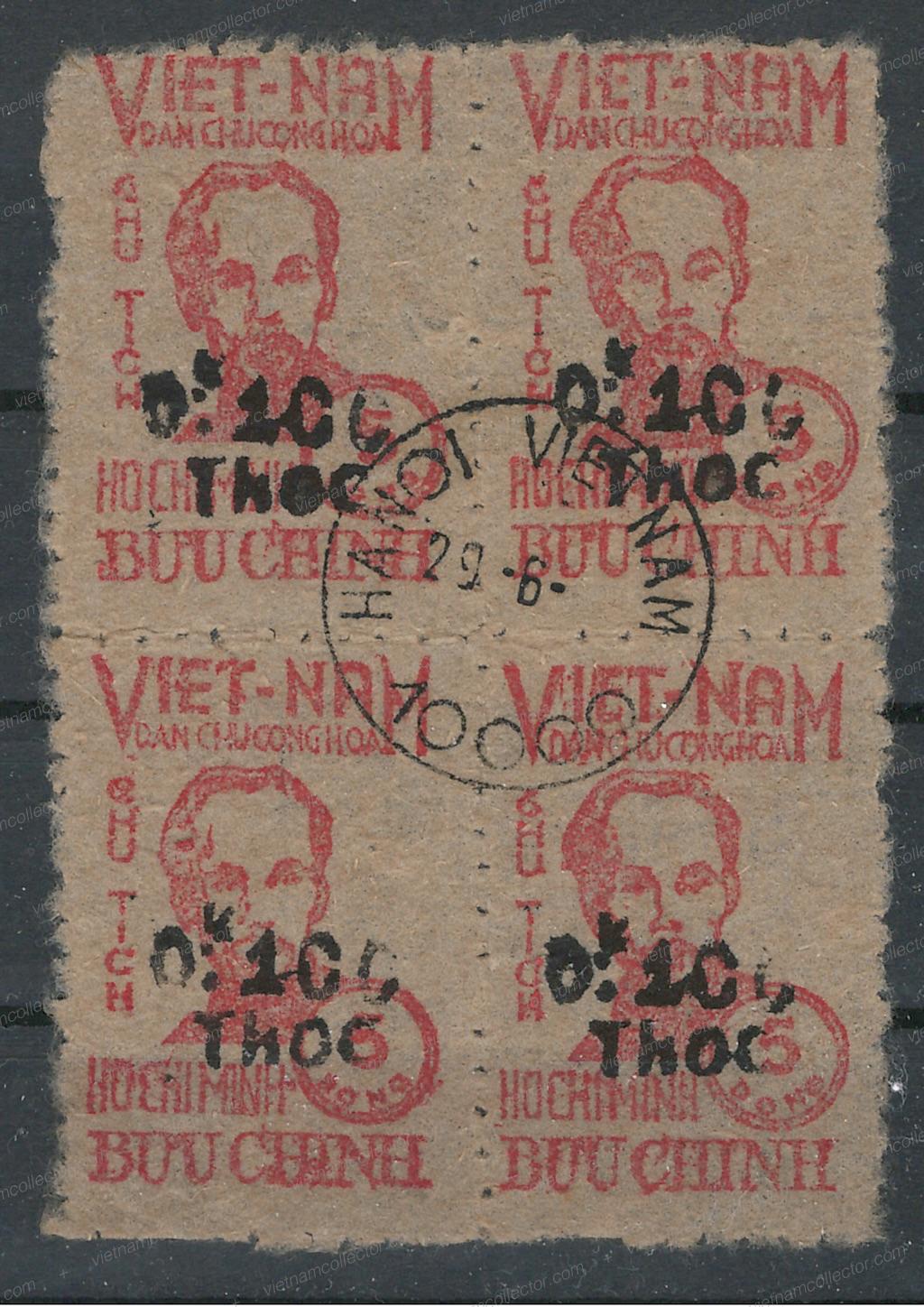
Detailed scan of the forged overprint.
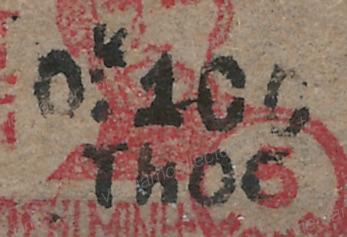
Here is mint block of four with a forged overprint that is vertically smaller than the original (note the different shape the”k” and the smaller uncolored area inside the “0”s). Also note especially the garbled impression of “T” and “h” in the word “Thoc” which is much clearer and more defined on the originals. 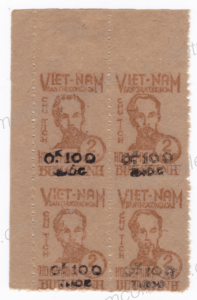
A detailed scan of the forged overprint.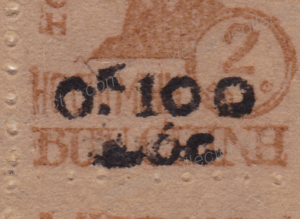
Here is a mint block of four of the forgery type where the numbers and the letters in “Thoc” touch each other. 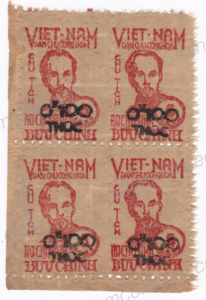
A Details scan of the forged overprint.
Also beware the editor saw recently a forged overprint on E-Bay and Delcampe. All stamps had a small pencil writing “Scheller” right side up at the bottom left of the stamps (Scheller is a authenticator of Indochinese/Vietnam stamps in France). Clearly this pencil writing must have ben forged as well as the signature was placed diagonally (which is normally reserved for rouletted stamps only). A correct authentication remark for mint perforated should have been place at the bottom left side, with the name starting at the corner parallel to the perforation. So beware, just because someone writes the name of an authenticator on the back of stamps does not make them genuine.
Registration Nr. 100040


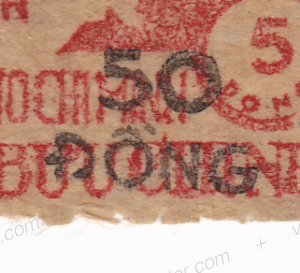
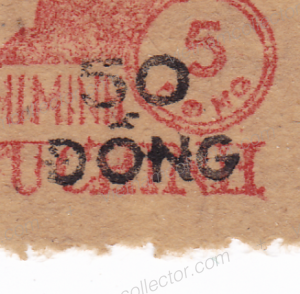
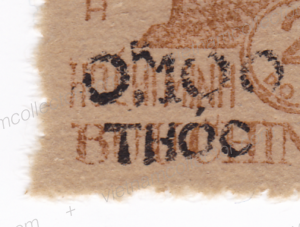
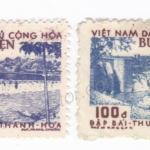
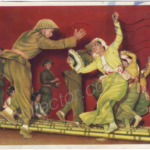


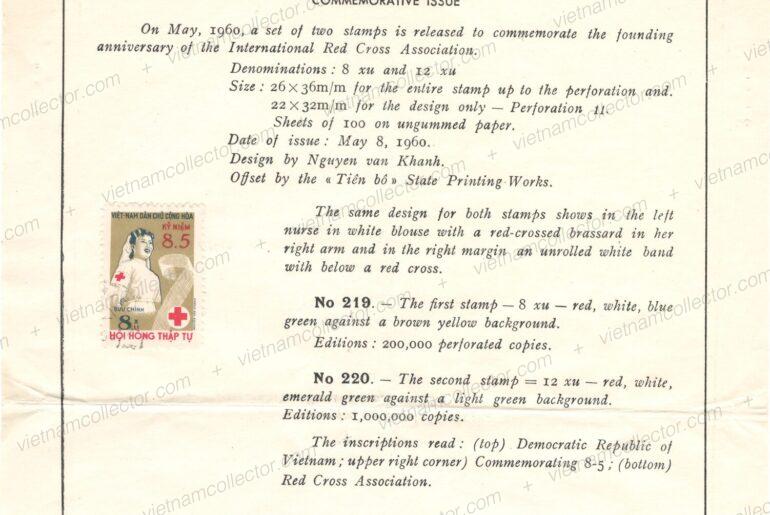
Comments are closed.